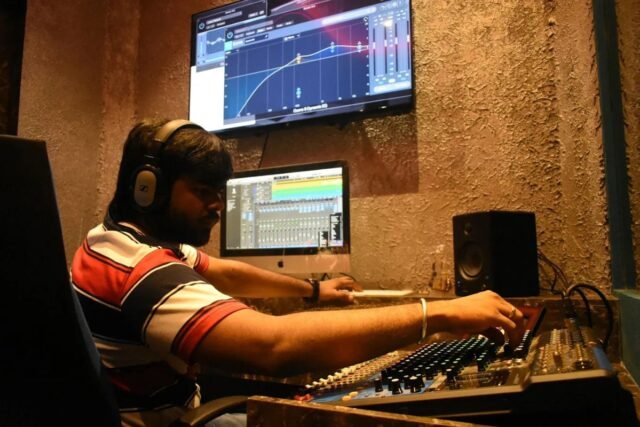Music production has progressed a far cry from clunky analog equipment and reel-to-reel tapes. With today’s digital age, all you require is a computer, headphones, and the appropriate software to produce tracks of professional caliber. This robust software is referred to as a DAW—Digital Audio Workstation. Two of the greatest and most respected DAWs in the realm of contemporary production are Pro Tools and Logic. These software platforms have revolutionized the way music is produced, edited, and distributed.
If you’re entering the realm of sound through music production courses in Chennai, learning Pro Tools and Logic is probably one of your earliest major steps. These programs provide you with practical skills in composing, recording, and mixing—laying down the groundwork you require for a successful music career.
What is a DAW and Why Does It Matter?
A DAW is not just a piece of software—it’s the center of your music-making world. It can be used to record, play virtual instruments, mix tracks, and apply effects all from the one place. With a DAW and minimal gear, you can create an entire song.
Pro Tools and Logic have varying workflows but are equally capable. Pro Tools is renowned for its transparent editing and precision mixing environment. Logic, on the other hand, is known for its creative features and clean interface, particularly for composers, songwriters, and electronic musicians.
Recording Audio: Construct the Backbone of Your Track
Recording is the core of production. Whether it’s a vocal, guitar, or live instrument, both Logic and Pro Tools make it simple to record professional-sounding audio. Simply plug in a microphone into your interface and record. The software records your performance in real time and provides you with tools to mold it.
With Pro Tools, you get real precision editing that’s ideal for refining every take. Its punch-in features and detailed waveform control let you polish vocals and instruments to perfection. Logic’s interface simplifies the process for a new user. The loop-based workflow helps artists capture creativity quickly and organize ideas efficiently.
Using MIDI and Virtual Instruments
One of the most thrilling things about digital creation is MIDI. You can use it to program instruments—even if you’re unable to play them yourself. You can program drums, pianos, synths, bass lines, and more using MIDI.
Logic includes a vast library of built-in sounds, ranging from natural strings to contemporary electronic textures. Its MIDI editor is intuitive yet versatile, allowing easy adjusting of notes and trying out harmonies and grooves.
Pro Tools, although historically audio-centric, now also features robust MIDI capabilities. It provides exact MIDI control, which is helpful for making hybrid tracks with real instruments mixed together with digital sound.
Editing and Organizing Your Song
Now that you’ve recorded your tracks, it’s time to organize them into a finished song. Pro Tools and Logic both allow easy cutting, copying, pasting, moving, and repeating of audio or MIDI clips.
Pro Tools includes precise editing tools that suit it well for post-production and commercial sound. Its grid and playlist feature also allow you to easily handle multiple versions of take.
Logic’s interface is more focused on creative flow. You can color-code parts, place arrangement markers, and drag-and-drop areas to refashion your song rapidly. It’s particularly helpful when you wish to test your song structure and try new things without destroying your workflow.
Mixing: Balance and Polish Your Track
Mixing is where you combine all the parts of your song in a way that they sound good together. You’ll balance volume levels, add EQ, add reverb, and put instruments out in the stereo field.
Pro Tools is arguably the top DAW for mixing. Its channel strip interface replicates vintage mixing boards, so it’s popular among pro engineers. You can automate effects, set up bus channels, and use advanced plugins with great accuracy.
Logic also includes a powerful mix console with effects and routings built in. It’s made easy to use with smart controls and track stacks, making it easy for new producers to learn about mixing without feeling overwhelmed.
Mastering: The Final Touch
Mastering is the art of getting your final track to sound refined and uniform. This means adding a little subtle EQ, managing loudness, and getting your song ready to stream, radio, or perform.
Both Pro Tools and Logic provide mastering tools in the software. You’re able to use limiters, stereo imaging tools, and meters to finish your track. Logic’s presets can guide beginners through the mastering process, while Pro Tools provides professionals with more granular adjustments for intricate sessions.
Increasing with Practice and Education
The more you work with your DAW, the stronger your skills will be. You’ll become proficient in shortcuts, learn how to optimize your own workflow, and find new creative maneuvers. If you’re making beats, live recording vocals, or mixing a whole album, your DAW is your creative playground.
Those who wish to take on further training typically seek out Sound Engineering Courses in Bangalore, where they are able to further their understanding of sound design, mixing theory, and studio equipment. These types of courses tend to be DAW training-based as a foundation module, affirming the necessity to learn to master tools such as Pro Tools and Logic.
Conclusion: Your Sound, Your Tools, Your Journey
The digital era has made it possible for greater numbers of people to create music than ever before. You don’t require a massive studio to create a hit—just creativity and the appropriate software.
Pro Tools and Logic are not merely programs—they’re collaborators on your musical journey. No matter whether you’re recording your first tune or creating a professional recording, these DAWs assist in bringing your idea into existence.
So put your headphones on, fire up your DAW, and begin composing. With regular practice and a love of sound, the music that lives inside you can become the music the world does.







